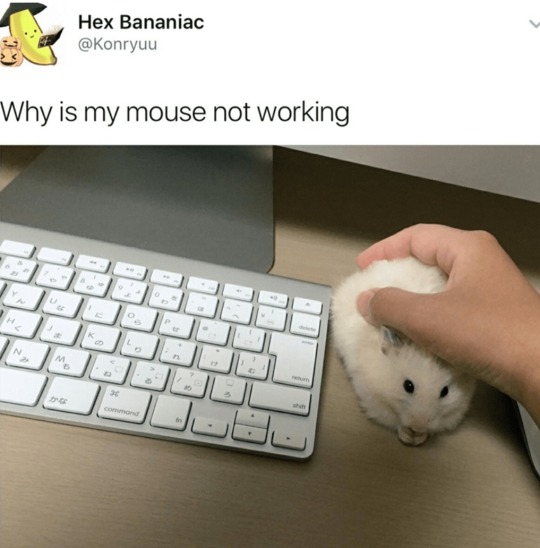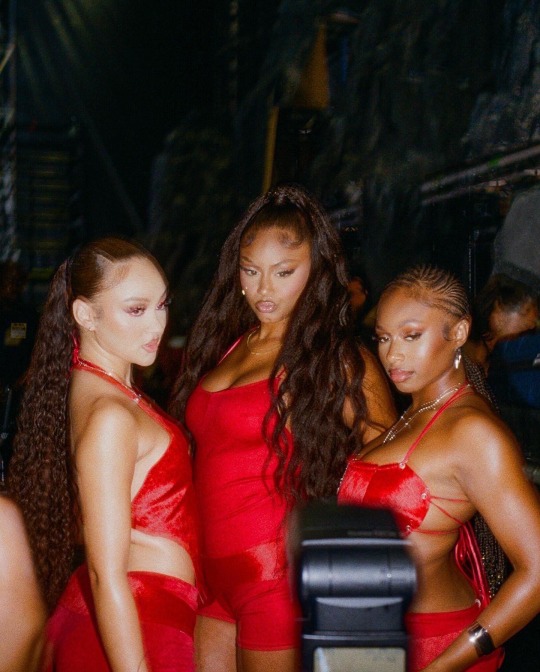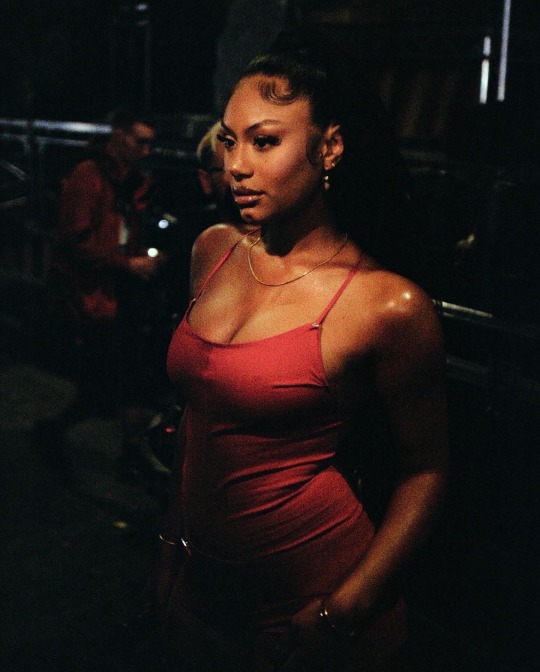#WIRELESS
Explore tagged Tumblr posts
Text
You bring a mousegirl over to your place, and she’s super self-conscious about the fact that she’s old-fashioned and needs to be plugged directly into a USB port to function and isn’t modern and wireless, and she’s just so happy and relieved when you tell her that you prefer wired mousegirls and are glad that you don’t have to worry about batteries and keeping track of easy-to-lose dongles and pairing them with their associated mice, etc.
(Not that you’re judging wireless mousegirls – they can’t help how Logitech made ‘em – but you do have preferences.)
(Really, maybe the first person would be more appropriate than the second person here.)
1K notes
·
View notes
Photo




REMA | Linking Up With Artist At Wireless Festival
#Rema#Wireless Festival#Wireless#London#Best Dressed#Outfits#Fit Check#Music#Concert#Festival#Show#Afrobearts#Africa#African Artist#Art#Good Music#Music Recs#Backstage#behind the scenes
232 notes
·
View notes
Text
I feel the pain of every woman who was born into this world so no I can't let it go
#booklr#female rage#radical feminist community#book quotes#books#books and reading#radical feminist safe#bell hooks#female hysteria#female writers#radical feminist theory#radical feminists do touch#radical misandrist#radblr#radical feminism#radical feminists do interact#feminism#bookblr#writerblr#essay writing#writeblr#writblr#writers on tumblr#writing#writerscommunity#wireless#poets on tumblr#new poets society#freedom#women
146 notes
·
View notes
Text
“Right,” begins Draco, heart hammering against his ribcage, “well then–” but Potter’s on him, over him, catching Draco by the nape of his neck as the mattress dips, and now there’s no sentence left to finish, nothing left in Draco’s brain at all. Potter’s possessed by some fresh surety, kneeling up over Draco and reeling him in with a tight fist to the back of his t-shirt, the fabric pulling tight across Draco’s neck, holding him in place as their lips finally meet. The kiss is the same: furious, frenzied, the kind of kiss that’s a claim; the kind of kiss that’s proof.
Quote from a gorgeous, clever, hot and funny fic Closing Time by @sweet-s0rr0w (Drarry, E, 18,4k)

105 notes
·
View notes
Text
🚢 Tesla's Remote Control Patent: The Birth of Modern Automation 🚢

On November 8, 1898, Nikola Tesla was granted U.S. Patent No. 613,809 for his "Method of and Apparatus for Controlling Mechanism of Moving Vessels or Vehicles." This invention wasn’t just the first practical remote control—it marked a revolutionary step toward the development of wireless communication and automation.
🔧 How Tesla’s System Worked 🔧
Tesla's system worked much like how we control drones today—only over a century ago!
1️⃣ Transmitter: Tesla used radio waves to send wireless commands to the vessel.
2️⃣ Receiver: The vessel had a sensitive device that decoded the radio signals into specific actions, such as steering or powering motors.
3️⃣ Control Circuits: Tesla designed a series of circuits that ensured each command executed reliably, preventing errors and interference.

⚙️ Key Features ⚙️
💡 Command Logic: Tesla's circuits functioned like a primitive decision-making system, linking specific signals to specific actions—a conceptual precursor to today’s logic gates.
🔋 Multi-Channel Design: Each circuit operated on a unique frequency, akin to modern multi-device networks, ensuring precise control without interference.
🛡️ Safety First: Tesla implemented mechanisms to prevent accidental or incorrect activations, prioritizing reliability.

🌍 Applications Then and Now 🌍
Tesla saw the potential for:
✔️ Military Use: Guiding unmanned ships or torpedoes.
✔️ Disaster Response: Sending unmanned vessels into dangerous areas.
✔️ Remote Automation: Introducing wireless precision to various industries.
Today, Tesla's vision echoes in:
🚁 Drones: Controlled remotely through radio signals.
🤖 Robots: Autonomous machines performing tasks with precision.
🏠 Smart Homes: Devices responding to commands over Wi-Fi.
🏭 Automated Factories: Machines operating through programmable controls Tesla helped inspire.
🌟 Why Tesla’s Invention Matters 🌟
Tesla didn’t just create a remote control—he pioneered a framework for wireless systems that continues to shape modern technology. What are your thoughts on Tesla's advancement in wireless technology?
68 notes
·
View notes
Photo

Source details and larger version.
Tune into this weird collection of vintage radio imagery.
48 notes
·
View notes
Text

Oscar Wuertz instructing a youngster in the art of making his own wireless set in a Brooklyn radio shop, ca. 1922.
Photo: Underwood & Underwood via getarchive.net
#vintage New York#1920s#vintage radio#homemade radio#wireless#radio shop#shopkeeper#vintage Brooklyn
90 notes
·
View notes
Text

✫・゚*.2006・゚✫*.
#2006#flickr#digital archiving#digitalmemoriez#wireless#internet#sign#signage#2000's nostalgia#early 00s#00s nostalgia#summer#summer nostalgia
57 notes
·
View notes
Text

#memes#meme#throwback#lol#funny#lol memes#funny memes#funny meme haha#funny stuff#wireless#wireless mouse#wireless mice are hamsters#i will not elaborate#hamster#so cute#cute animals#kawaii#cute#pets are the best#pets are family#cute pets#pets#pet#computers#computer gear#computer#it jobs#old tech#technology#tech
130 notes
·
View notes
Text

Stormy Weather by @mintawasalreadytaken (17k, M)
Tags: Angst, Power Imbalance, Roleplay, Under-Negotiated Kink
“I'm losing it, Potter. Please stay. Just, five minutes. Two, two minutes—“ “Stop.” Malfoy raised his chin. Pride shone in his pinched face, though his chin wobbled. Ever the little prince on his throne. Harry didn't care. He was numb. In and out. In and out. He unfurled the parchment and ticked the boxes, scribbling something approximating a date and time. In the foyer, he refused to look down the hall at the sound of the fridge door opening. Glasses tinkled as he tied his shoes. The pop of a cork from a bottle had never before sounded lonely, and he was thankful for the gale outside to strip further sounds from reaching him as he shut the door and stepped back out into the storm.
(rec by @mallstars)
#drarry#drarry fic rec#drarry fanfics#hpdm#harry x draco#drarry fic#mintawasalreadytaken#rec by mallstars#2024#wireless#wireless 2024
27 notes
·
View notes
Photo

Without Wires
Inspired by an old commercial from the 90s or 2000s I saw a few weeks back, buried within a compilation of recorded commercial breaks over on YouTube. It was an advertisement for a mobile phone service that showcased the freedom of going "wireless" by having a flock of birds sit on "wireless" (invisible) telephone pole wires.
#without wires#original character#annalogue#mime#mime girl#telephone pole#clouds#monochrome art#black and white art#doodle#doodle art#wires#wireless#cables#art#artists on tumblr
13 notes
·
View notes
Text

They are talking
#oneshot game#oneshot niko#the world machine oneshot#doodle#communication#wireless#they are the future
162 notes
·
View notes
Photo





REMA | On Stage Performing At Wireless Festival
#Rema#Wireless#Festival#Performance#Afrobeats#Nigeria#African Music#Music#New Music#HEIS#Album#Album Art#Show#Fashion#Style#Stylist
69 notes
·
View notes
Text





FLO x Wireless Festival (2023)
#flo#wireless#black girl magic#stella quaresma#jorja douglas#renee downer#beauty#black beauty#flolikethis#pro-royalty
189 notes
·
View notes
Text
They finish, then, together, and Draco slides off Harry, panting, all the tiredness and sadness coming back in waves; wave after wave after wave. Harry’s kissing his face, his lips, his tears, and they fall asleep like that, half dressed, tangled, dirty, guilty. * * * They don’t talk, but they have sex again in the middle of the night, and one more time in the morning. It’s like a lifelong thirst that will never be satiated. It’s like a crime they must get the most out of, before they receive their sentence.
Quote from the incredible, angsty, aching, perfect fic The most he's ever said by @fastbrother (drarry, E, 16,4k)

#quick quotes recs#QQR#The most he's ever said#Anon#fic rec#I can't WAIT for reveals#wireless#drarry
100 notes
·
View notes
Text
Reviving Tesla’s Dream: The Future of Wireless Power Transmission

“My project was retarded by the laws of nature. The world was not prepared for it. It was too far ahead of time. But the same laws will prevail in the end and make it a triumphal success.” – Nikola Tesla
In the early days of radio technology, there was a crucial decision point that split wireless technology into two distinct paths. One path, pursued by Marconi and others, focused on electromagnetic wave transmission. The other path, championed by Nikola Tesla, aimed to minimize electromagnetic waves and use the Earth itself for energy transmission. While the world predominantly embraced the former, Tesla’s innovative approach was largely forgotten. Let’s explore Tesla’s lost art.
Tesla's wireless power transmission system, often known as his "Magnifying Transmitter," was a pioneering approach to sending electrical energy over long distances. Unlike today’s wireless technologies, which rely on electromagnetic waves, Tesla's design aimed to transmit energy through the earth, which he believed was more efficient.

Tesla showcased his system’s potential during his 1899 experiments in Colorado Springs. He successfully transmitted energy through the ground, illuminating bulbs about a mile away from the transmitter. Tesla saw this as a matter of engineering: just as a machine that can throw a rock 5 feet can be engineered to throw it 1,000 feet, he believed his system could be adjusted to transmit power across any distance on Earth.
Modern wireless technologies, such as radio, Wi-Fi, and cellular networks, use electromagnetic waves that spread outward from a source. These waves lose strength according to the inverse square law, which means signal strength decreases with the square of the distance from the source. This energy loss is a significant limitation for long-distance communication and power transmission.
Tesla’s vision was quite different. He recognized that while electromagnetic waves were effective for communication, they were inefficient for transmitting large amounts of power. As he put it, “I only used low alternations, and I produced 90 percent in current energy and only 10 percent in electromagnetic waves, which are wasted.” Tesla aimed to minimize electromagnetic radiation, which he considered to be energy-draining. Instead, he focused on transmitting energy through the earth, which he believed was more efficient and recoverable.

Tesla's system utilized a large coil known as the "Magnifying Transmitter," which generated a high-voltage, low-frequency current. This design featured significant self-inductance and minimal capacitance, producing a strong resonant effect. By accumulating and directing massive amounts of energy with minimal losses, Tesla aimed for efficient power transmission. As he explained, “I accumulate in that circuit a tremendous energy... I prefer to reduce those waves in quantity and pass a current into the earth, because electromagnetic wave energy is not recoverable while the earth current is entirely recoverable, being the energy stored in an elastic system.”
The scientific principles of Tesla's system include:
1. Resonant Circuits: Tesla's system used resonant circuits, tuning the primary and secondary coils to the same frequency. This resonance allowed for efficient energy transfer between coils, amplifying energy while minimizing losses.
2. Self-Inductance: A key component of Tesla’s system was self-inductance. A large coil with high self-inductance generated a strong magnetic field essential for creating high-voltage, low-frequency current. Self-inductance helped store energy in the coil’s magnetic field, critical for high power levels.
3. Capacitance: Tesla’s design involved large capacitors to store electrical energy. Capacitance was kept small compared to self-inductance to achieve desired resonant effects. The capacitors would discharge rapidly, creating high-voltage pulses for transmission through the earth.
To construct a system similar to Tesla’s, he advised:
1. Low Frequency, High Voltage Design: Build a large Tesla coil to generate high voltages at low frequencies. Ensure the design minimizes electromagnetic radiation and focuses on efficient energy transfer into the ground.
2. Loose Coupling for Resonance: Use loose coupling between the primary and secondary coils to achieve significant resonant rise. The coils should be inductively linked but not too close to avoid direct energy transfer.
3. Earth Connection: Establish a deep, effective ground connection to allow the transmitter to send electrical currents into the earth, utilizing its natural conductive properties.
4. Minimizing Radiation: Design the system to suppress electromagnetic radiation, aiming to retain energy within the circuit and direct it into the ground. Tune the system to maximize energy storage and transfer.
5. Energy Storage and Discharge: Incorporate large capacitors for storing and rapidly discharging energy to create high-voltage, low-frequency oscillations.

Tesla’s system faced significant challenges, including the need for large, expensive equipment. In 1914, he estimated the cost of his "Magnifying Transmitter" at $450,000—around $15 million today. These financial constraints prevented him from fully realizing his dream and unfortunately led to his public image as a mad scientist with unrealistic future visions. However, the potential applications of his system are vast, from global wireless power transmission to reducing infrastructure costs and powering remote areas. With ongoing advancements in technology, Tesla’s vision may be within reach.
Tesla’s system presents an alternative approach to wireless energy transmission, focusing on efficiency and long-distance power transfer over the broad dispersal of electromagnetic waves. While modern technologies have advanced in different ways, Tesla’s principles—especially his focus on resonant circuits and earth currents—provide valuable insights into alternative methods of energy transmission. Exploring these principles today could lead to innovative applications, such as more efficient long-distance power transmission or new energy transfer methods.
#nikola tesla#science#history#wireless#energy#power#technology#quotes#ahead of his time#ahead of our time
117 notes
·
View notes